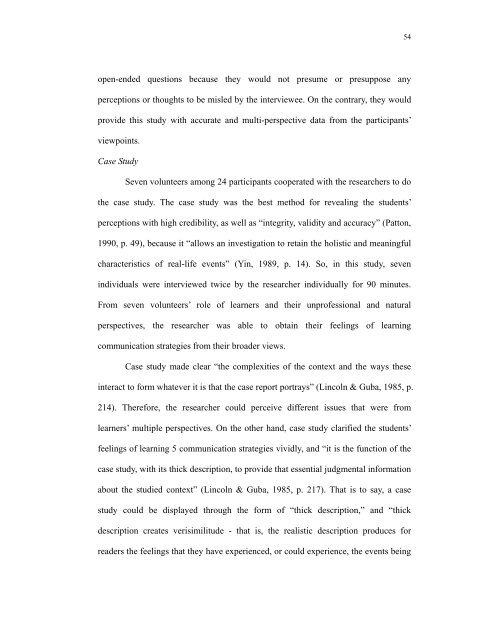A Dissertation by GRACE HUI-CHIN LIN Submitted to the Office of ...
A Dissertation by GRACE HUI-CHIN LIN Submitted to the Office of ...
A Dissertation by GRACE HUI-CHIN LIN Submitted to the Office of ...
You also want an ePaper? Increase the reach of your titles
YUMPU automatically turns print PDFs into web optimized ePapers that Google loves.
open-ended questions because <strong>the</strong>y would not presume or presuppose any<br />
perceptions or thoughts <strong>to</strong> be misled <strong>by</strong> <strong>the</strong> interviewee. On <strong>the</strong> contrary, <strong>the</strong>y would<br />
provide this study with accurate and multi-perspective data from <strong>the</strong> participants’<br />
viewpoints.<br />
Case Study<br />
Seven volunteers among 24 participants cooperated with <strong>the</strong> researchers <strong>to</strong> do<br />
<strong>the</strong> case study. The case study was <strong>the</strong> best method for revealing <strong>the</strong> students’<br />
perceptions with high credibility, as well as “integrity, validity and accuracy” (Pat<strong>to</strong>n,<br />
1990, p. 49), because it “allows an investigation <strong>to</strong> retain <strong>the</strong> holistic and meaningful<br />
characteristics <strong>of</strong> real-life events” (Yin, 1989, p. 14). So, in this study, seven<br />
individuals were interviewed twice <strong>by</strong> <strong>the</strong> researcher individually for 90 minutes.<br />
From seven volunteers’ role <strong>of</strong> learners and <strong>the</strong>ir unpr<strong>of</strong>essional and natural<br />
perspectives, <strong>the</strong> researcher was able <strong>to</strong> obtain <strong>the</strong>ir feelings <strong>of</strong> learning<br />
communication strategies from <strong>the</strong>ir broader views.<br />
Case study made clear “<strong>the</strong> complexities <strong>of</strong> <strong>the</strong> context and <strong>the</strong> ways <strong>the</strong>se<br />
interact <strong>to</strong> form whatever it is that <strong>the</strong> case report portrays” (Lincoln & Guba, 1985, p.<br />
214). Therefore, <strong>the</strong> researcher could perceive different issues that were from<br />
learners’ multiple perspectives. On <strong>the</strong> o<strong>the</strong>r hand, case study clarified <strong>the</strong> students’<br />
feelings <strong>of</strong> learning 5 communication strategies vividly, and “it is <strong>the</strong> function <strong>of</strong> <strong>the</strong><br />
case study, with its thick description, <strong>to</strong> provide that essential judgmental information<br />
about <strong>the</strong> studied context” (Lincoln & Guba, 1985, p. 217). That is <strong>to</strong> say, a case<br />
study could be displayed through <strong>the</strong> form <strong>of</strong> “thick description,” and “thick<br />
description creates verisimilitude - that is, <strong>the</strong> realistic description produces for<br />
readers <strong>the</strong> feelings that <strong>the</strong>y have experienced, or could experience, <strong>the</strong> events being<br />
54
















